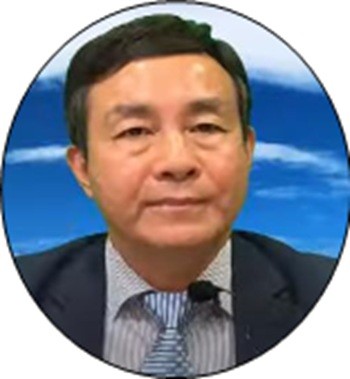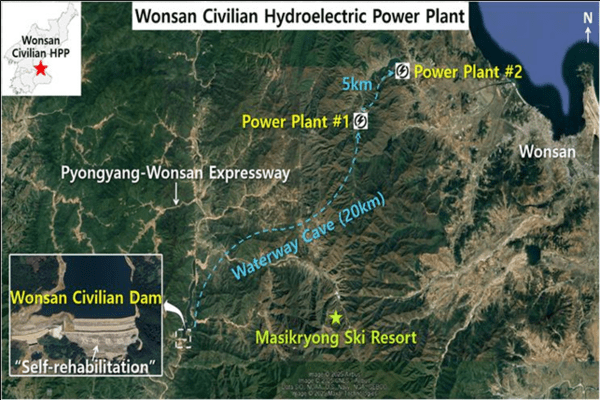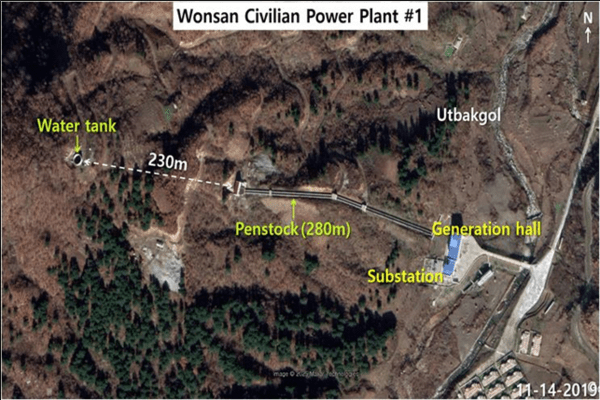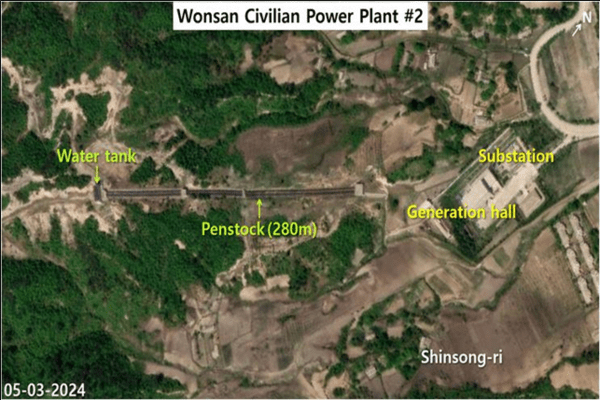
North Korea, which suffers from chronic power shortages, is said to transmit electricity only for a few hours a day even in Pyongyang, the self-proclaimed "capital of revolution," not to mention provinces. Hydroelectric power plants that generate about 62-63% of North Korea's electricity are estimated to have 6,500-8,000 units combined for small and medium-sized power plants. Among them, satellite images were used to examine the current status of the Wonsan Civilian Power Plant built with the "Kangwon Province Spirit" of self-reliance in Kim Jong-un's hometown of Wonsan.
The Wonsan Civilian Power Plant, which was Kim Jong-il's instruction, was built by turning the river flowing into the West Sea into the East Sea in a basin change. It was completed on April 29, 2016. It is a representative result of the "Kangwon Province Spirit" especially emphasized in North Korea and is revered as a self-reliance creation that was built by the county residents without support from the Central Party. During the construction, Kim Jong-un paid attention and visited several times for local guidance.

The Wonsan Civilian Dam was built by blocking the valley water that would flow to the West Sea from Bupdong County, an inland mountainous area in Kangwon Province. When the concrete wall of the dam in the image is zoomed in on, it is identified that the four Korean letters "self-reliance" are written in a large size of 23m wide and 33m long. It symbolizes the pride that the county residents created with pure bare fist of "Kangwon Province Spirit" without support from the Central Party.
After the dam was built, the first power plant was built in Utbakgol, Wonsan, by turning the waterway in the direction of the East Sea, breaking through an underground waterway tunnel to a distance of about 20km. Again, the second power plant was built by inducing a waterway underground to Shinsong Town, a distance of 5km east of there. Between the dam and the Power Plant #1, a highway connecting Pyongyang-Wonsan crossing the waterway cave passes, and Masikryong Ski Resort is nearby.


The Wonsan Civilian Power Plant has two power plants with a total power generation capacity of 40,000kW and is a typical 'river change type' hydroelectric power plant. The watershed change type refers to installing dams and tunnels in the mainstream or upstream of the river and artificially changing the water stream to flow in a different direction from the original.
Wonsan Civilian Power Plant generates electricity by building a dam in Bupdong County, Kangwon Province, upstream of the Imjin River, and drilling a 3-meter-diameter waterway tunnel across Masikryong pass for more than 20km to turn the flowing river into the East Sea. While building Power Plants #1 and #2, more than 100 employees' houses were also built together.
In early May 2020, a large fire broke out at the Wonsan Civilian Power Plant, and the operation was suspended for about 15 days. At that time, power plant officials kept it secret and cracked down strictly to prevent leakage of words, fearing that they would be punished for economic losses and causing concern to Kim Jong-un. After a lot of hard work, the executives couldn't breathe and made hard efforts, feeling that if the secret was released outside, all the executives would die, and Kim Jong-un sent a handwritten letter two days after the operation.
In the letter, he praised it, saying, "It is a creation of self-reliance, and it is a power plant for wealthy people who have realized the patriotic aspirations of the general (Kim Jong-il) and the desire for a powerhouse." Only then did the power plant officials breathe out of relief in an emotional response, and even held a rally to support the great leader's handwritten letter and strengthen their determination to innovate further. The Wonsan Civilian Power Plant symbolizes North Korea's self-reliance "Kangwon Province Spirit." Since then, learning along with the "Kangwon Province Spirit" has spread throughout North Korea.
In Wonsan, Kangwon Province, there are Wonsan Civilian Power Plant, which was completed in April 2016, and Wonsan Youth Power Plant, which was completed in 2009. Two hydroelectric power plants have produced electricity and supplied it to the area of Wonsan. On July 1, the Wonsan-Kalma Coastal Tourism District opened 11 years after its construction began.
However, satellite imagery analysis revealed that after pulling much of the electricity used in Wonsan, it is now used not only to operate tourist entertainment facilities on the Kalma Peninsula, but also to focus on colorful night lights at night. The private electricity supplied to the Wonsan area is limited, and it is understood that a significant amount of it is used to operate recreational facilities in the Kalma Coastal Tourism District.
